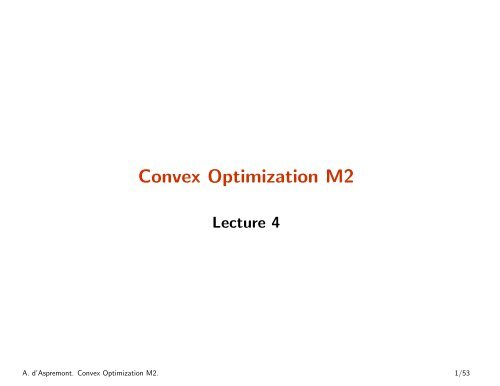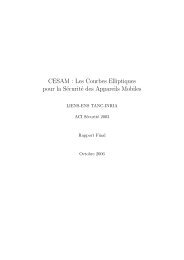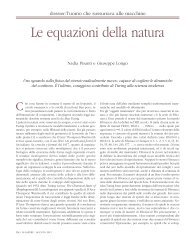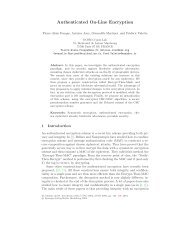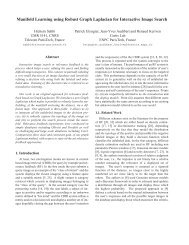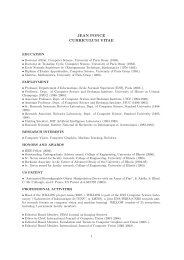Newton's method
Newton's method
Newton's method
You also want an ePaper? Increase the reach of your titles
YUMPU automatically turns print PDFs into web optimized ePapers that Google loves.
Convex Optimization M2<br />
Lecture 4<br />
A. d’Aspremont. Convex Optimization M2. 1/53
Unconstrained minimization<br />
A. d’Aspremont. Convex Optimization M2. 2/53
Unconstrained minimization<br />
<br />
<br />
<br />
<br />
<br />
<br />
terminology and assumptions<br />
gradient descent <strong>method</strong><br />
steepest descent <strong>method</strong><br />
Newton’s <strong>method</strong><br />
self-concordant functions<br />
implementation<br />
A. d’Aspremont. Convex Optimization M2. 3/53
Unconstrained minimization<br />
minimize<br />
f(x)<br />
<br />
<br />
f convex, twice continuously differentiable (hence dom f open)<br />
we assume optimal value p ⋆ = inf x f(x) is attained (and finite)<br />
unconstrained minimization <strong>method</strong>s<br />
<br />
produce sequence of points x (k) ∈ dom f, k = 0, 1, . . . with<br />
f(x (k) ) → p ⋆<br />
<br />
can be interpreted as iterative <strong>method</strong>s for solving optimality condition<br />
∇f(x ⋆ ) = 0<br />
A. d’Aspremont. Convex Optimization M2. 4/53
Initial point and sublevel set<br />
algorithms in this chapter require a starting point x (0) such that<br />
<br />
<br />
x (0) ∈ dom f<br />
sublevel set S = {x | f(x) ≤ f(x (0) )} is closed<br />
2nd condition is hard to verify, except when all sublevel sets are closed:<br />
<br />
<br />
<br />
equivalent to condition that epi f is closed<br />
true if dom f = R n<br />
true if f(x) → ∞ as x → bd dom f<br />
examples of differentiable functions with closed sublevel sets:<br />
m∑<br />
f(x) = log( exp(a T i x + b i )),<br />
i=1<br />
f(x) = −<br />
m∑<br />
log(b i − a T i x)<br />
i=1<br />
A. d’Aspremont. Convex Optimization M2. 5/53
Strong convexity and implications<br />
f is strongly convex on S if there exists an m > 0 such that<br />
∇ 2 f(x) ≽ mI<br />
for all x ∈ S<br />
implications<br />
for x, y ∈ S,<br />
f(y) ≥ f(x) + ∇f(x) T (y − x) + m 2 ‖x − y‖2 2<br />
hence, S is bounded<br />
p ⋆ > −∞, and for x ∈ S,<br />
f(x) − p ⋆ ≤ 1<br />
2m ‖∇f(x)‖2 2<br />
useful as stopping criterion (if you know m)<br />
A. d’Aspremont. Convex Optimization M2. 6/53
Descent <strong>method</strong>s<br />
x (k+1) = x (k) + t (k) ∆x (k) with f(x (k+1) ) < f(x (k) )<br />
<br />
<br />
other notations: x + = x + t∆x, x := x + t∆x<br />
∆x is the step, or search direction; t is the step size, or step length<br />
from convexity, f(x + ) < f(x) implies ∇f(x) T ∆x < 0<br />
(i.e., ∆x is a descent direction)<br />
General descent <strong>method</strong>.<br />
given a starting point x ∈ dom f.<br />
repeat<br />
1. Determine a descent direction ∆x.<br />
2. Line search. Choose a step size t > 0.<br />
3. Update. x := x + t∆x.<br />
until stopping criterion is satisfied.<br />
A. d’Aspremont. Convex Optimization M2. 7/53
Line search types<br />
exact line search: t = argmin t>0 f(x + t∆x)<br />
backtracking line search (with parameters α ∈ (0, 1/2), β ∈ (0, 1))<br />
<br />
starting at t = 1, repeat t := βt until<br />
f(x + t∆x) < f(x) + αt∇f(x) T ∆x<br />
graphical interpretation: backtrack until t ≤ t 0<br />
t<br />
f(x + t∆x)<br />
f(x) + t∇f(x) T ∆x f(x) + αt∇f(x) T ∆x<br />
t = 0 t 0<br />
A. d’Aspremont. Convex Optimization M2. 8/53
Gradient descent <strong>method</strong><br />
general descent <strong>method</strong> with ∆x = −∇f(x)<br />
given a starting point x ∈ dom f.<br />
repeat<br />
1. ∆x := −∇f(x).<br />
2. Line search. Choose step size t via exact or backtracking line search.<br />
3. Update. x := x + t∆x.<br />
until stopping criterion is satisfied.<br />
<br />
stopping criterion usually of the form ‖∇f(x)‖ 2 ≤ ɛ<br />
convergence result: for strongly convex f,<br />
f(x (k) ) − p ⋆ ≤ c k (f(x (0) ) − p ⋆ )<br />
c ∈ (0, 1) depends on m, x (0) , line search type<br />
<br />
very simple, but often very slow; rarely used in practice<br />
A. d’Aspremont. Convex Optimization M2. 9/53
quadratic problem in R 2<br />
f(x) = (1/2)(x 2 1 + γx 2 2) (γ > 0)<br />
with exact line search, starting at x (0) = (γ, 1):<br />
x (k)<br />
1 = γ<br />
( ) k γ − 1<br />
, x (k)<br />
2 =<br />
γ + 1<br />
(<br />
− γ − 1 ) k<br />
γ + 1<br />
very slow if γ ≫ 1 or γ ≪ 1<br />
example for γ = 10:<br />
4<br />
x2<br />
0<br />
x (1)<br />
x (0)<br />
−4<br />
−10 0 10<br />
x 1<br />
A. d’Aspremont. Convex Optimization M2. 10/53
nonquadratic example<br />
f(x 1 , x 2 ) = e x 1+3x 2 −0.1 + e x 1−3x 2 −0.1 + e −x 1−0.1<br />
x (0)<br />
x (0)<br />
x (2) x (1)<br />
x (1)<br />
backtracking line search<br />
exact line search<br />
A. d’Aspremont. Convex Optimization M2. 11/53
a problem in R 100<br />
f(x) = c T x −<br />
∑500<br />
i=1<br />
log(b i − a T i x)<br />
10 4<br />
10 2<br />
f(x (k) ) − p ⋆<br />
10 0<br />
10 −2<br />
exact l.s.<br />
k<br />
backtracking l.s.<br />
10 −4<br />
0 50 100 150 200<br />
‘linear’ convergence, i.e., a straight line on a semilog plot<br />
A. d’Aspremont. Convex Optimization M2. 12/53
Steepest descent <strong>method</strong><br />
normalized steepest descent direction (at x, for norm ‖ · ‖):<br />
∆x nsd = argmin{∇f(x) T v | ‖v‖ = 1}<br />
interpretation: for small v, f(x + v) ≈ f(x) + ∇f(x) T v;<br />
direction ∆x nsd is unit-norm step with most negative directional derivative<br />
(unnormalized) steepest descent direction<br />
∆x sd = ‖∇f(x)‖ ∗ ∆x nsd<br />
satisfies ∇f(x) T ∆ sd = −‖∇f(x)‖ 2 ∗<br />
steepest descent <strong>method</strong><br />
<br />
<br />
general descent <strong>method</strong> with ∆x = ∆x sd<br />
convergence properties similar to gradient descent<br />
A. d’Aspremont. Convex Optimization M2. 13/53
examples<br />
<br />
<br />
Euclidean norm: ∆x sd = −∇f(x)<br />
quadratic norm ‖x‖ P = (x T P x) 1/2 (P ∈ S n ++): ∆x sd = −P −1 ∇f(x)<br />
<br />
l 1 -norm: ∆x sd = −(∂f(x)/∂x i )e i , where |∂f(x)/∂x i | = ‖∇f(x)‖ ∞<br />
unit balls and normalized steepest descent directions for a quadratic norm and the<br />
l 1 -norm:<br />
−∇f(x)<br />
∆x nsd<br />
∆x nsd<br />
−∇f(x)<br />
A. d’Aspremont. Convex Optimization M2. 14/53
choice of norm for steepest descent<br />
x (0)<br />
x (0)<br />
x (2)<br />
x (1)<br />
<br />
steepest descent with backtracking line search for two quadratic norms<br />
ellipses show {x | ‖x − x (k) ‖ P = 1}<br />
equivalent interpretation of steepest descent with quadratic norm ‖ · ‖ P :<br />
gradient descent after change of variables ¯x = P 1/2 x<br />
shows choice of P has strong effect on speed of convergence<br />
A. d’Aspremont. Convex Optimization M2. 15/53
Newton step<br />
∆x nt = −∇ 2 f(x) −1 ∇f(x)<br />
interpretations<br />
<br />
x + ∆x nt minimizes second order approximation<br />
̂f(x + v) = f(x) + ∇f(x) T v + 1 2 vT ∇ 2 f(x)v<br />
<br />
x + ∆x nt solves linearized optimality condition<br />
∇f(x + v) ≈ ∇ ̂f(x + v) = ∇f(x) + ∇ 2 f(x)v = 0<br />
̂f ′<br />
(x,f(x))<br />
(x + ∆x nt ,f(x + ∆x nt ))<br />
̂f<br />
f<br />
0<br />
(x,f ′ (x))<br />
f ′<br />
(x + ∆x nt ,f ′ (x + ∆x nt ))<br />
A. d’Aspremont. Convex Optimization M2. 16/53
∆x nt is steepest descent direction at x in local Hessian norm<br />
‖u‖ ∇ 2 f(x) = ( u T ∇ 2 f(x)u ) 1/2<br />
x<br />
x + ∆x nsd<br />
x + ∆x nt<br />
dashed lines are contour lines of f; ellipse is {x + v | v T ∇ 2 f(x)v = 1} arrow<br />
shows −∇f(x)<br />
A. d’Aspremont. Convex Optimization M2. 17/53
Newton decrement<br />
a measure of the proximity of x to x ⋆<br />
properties<br />
λ(x) = ( ∇f(x) T ∇ 2 f(x) −1 ∇f(x) ) 1/2<br />
<br />
gives an estimate of f(x) − p ⋆ , using quadratic approximation ̂f:<br />
f(x) − inf<br />
y<br />
̂f(y) = 1 2 λ(x)2<br />
<br />
equal to the norm of the Newton step in the quadratic Hessian norm<br />
λ(x) = ( ∆x nt ∇ 2 f(x)∆x nt<br />
) 1/2<br />
directional derivative in the Newton direction: ∇f(x) T ∆x nt = −λ(x) 2<br />
affine invariant (unlike ‖∇f(x)‖ 2 )<br />
A. d’Aspremont. Convex Optimization M2. 18/53
Newton’s <strong>method</strong><br />
given a starting point x ∈ dom f, tolerance ɛ > 0.<br />
repeat<br />
1. Compute the Newton step and decrement.<br />
∆x nt := −∇ 2 f(x) −1 ∇f(x); λ 2 := ∇f(x) T ∇ 2 f(x) −1 ∇f(x).<br />
2. Stopping criterion. quit if λ 2 /2 ≤ ɛ.<br />
3. Line search. Choose step size t by backtracking line search.<br />
4. Update. x := x + t∆x nt .<br />
affine invariant, i.e., independent of linear changes of coordinates:<br />
Newton iterates for ˜f(y) = f(T y) with starting point y (0) = T −1 x (0) are<br />
y (k) = T −1 x (k)<br />
A. d’Aspremont. Convex Optimization M2. 19/53
Classical convergence analysis<br />
assumptions<br />
<br />
f strongly convex on S with constant m<br />
∇ 2 f is Lipschitz continuous on S, with constant L > 0:<br />
‖∇ 2 f(x) − ∇ 2 f(y)‖ 2 ≤ L‖x − y‖ 2<br />
(L measures how well f can be approximated by a quadratic function)<br />
outline: there exist constants η ∈ (0, m 2 /L), γ > 0 such that<br />
<br />
<br />
if ‖∇f(x)‖ 2 ≥ η, then f(x (k+1) ) − f(x (k) ) ≤ −γ<br />
if ‖∇f(x)‖ 2 < η, then<br />
L<br />
2m 2‖∇f(x(k+1) )‖ 2 ≤<br />
( L<br />
2m 2‖∇f(x(k) )‖ 2<br />
) 2<br />
A. d’Aspremont. Convex Optimization M2. 20/53
damped Newton phase (‖∇f(x)‖ 2 ≥ η)<br />
<br />
<br />
<br />
most iterations require backtracking steps<br />
function value decreases by at least γ<br />
if p ⋆ > −∞, this phase ends after at most (f(x (0) ) − p ⋆ )/γ iterations<br />
quadratically convergent phase (‖∇f(x)‖ 2 < η)<br />
all iterations use step size t = 1<br />
<br />
‖∇f(x)‖ 2 converges to zero quadratically: if ‖∇f(x (k) )‖ 2 < η, then<br />
L<br />
2m 2‖∇f(xl )‖ 2 ≤<br />
( L<br />
2m 2‖∇f(xk )‖ 2<br />
) 2<br />
l−k<br />
≤<br />
( 1<br />
2) 2<br />
l−k<br />
, l ≥ k<br />
A. d’Aspremont. Convex Optimization M2. 21/53
conclusion: number of iterations until f(x) − p ⋆ ≤ ɛ is bounded above by<br />
f(x (0) ) − p ⋆<br />
γ<br />
+ log 2 log 2 (ɛ 0 /ɛ)<br />
γ, ɛ 0 are constants that depend on m, L, x (0)<br />
<br />
<br />
<br />
second term is small (of the order of 6) and almost constant for practical<br />
purposes<br />
in practice, constants m, L (hence γ, ɛ 0 ) are usually unknown<br />
provides qualitative insight in convergence properties (i.e., explains two<br />
algorithm phases)<br />
A. d’Aspremont. Convex Optimization M2. 22/53
Examples<br />
example in R 2 (page 11)<br />
10 5<br />
x (0) x (1) k<br />
f(x (k) ) − p ⋆<br />
10 0<br />
10 −5<br />
10 −10<br />
10 −15<br />
0 1 2 3 4 5<br />
backtracking parameters α = 0.1, β = 0.7<br />
<br />
<br />
converges in only 5 steps<br />
quadratic local convergence<br />
A. d’Aspremont. Convex Optimization M2. 23/53
example in R 100 (page 12)<br />
2<br />
f(x (k) ) − p ⋆<br />
10 0<br />
10 −5<br />
10 −10<br />
10 5 exact line search<br />
k<br />
backtracking<br />
step size t (k)<br />
1.5<br />
1<br />
0.5<br />
exact line search<br />
backtracking<br />
10 −15<br />
0 2 4 6 8 10<br />
k<br />
0<br />
0 2 4 6 8<br />
backtracking parameters α = 0.01, β = 0.5<br />
<br />
<br />
backtracking line search almost as fast as exact l.s. (and much simpler)<br />
clearly shows two phases in algorithm<br />
A. d’Aspremont. Convex Optimization M2. 24/53
example in R 10000 (with sparse a i )<br />
f(x) = −<br />
10000<br />
∑<br />
i=1<br />
log(1 − x 2 i ) −<br />
100000<br />
∑<br />
i=1<br />
log(b i − a T i x)<br />
10 5<br />
f(x (k) ) − p ⋆<br />
10 0<br />
10 −5<br />
0 5 10 15 20<br />
k<br />
backtracking parameters α = 0.01, β = 0.5.<br />
<br />
performance similar as for small examples<br />
A. d’Aspremont. Convex Optimization M2. 25/53
Self-concordance<br />
shortcomings of classical convergence analysis<br />
depends on unknown constants (m, L, . . . )<br />
<br />
bound is not affinely invariant, although Newton’s <strong>method</strong> is<br />
convergence analysis via self-concordance (Nesterov and Nemirovski)<br />
<br />
<br />
<br />
<br />
does not depend on any unknown constants<br />
gives affine-invariant bound<br />
applies to special class of convex functions (‘self-concordant’ functions)<br />
developed to analyze polynomial-time interior-point <strong>method</strong>s for convex<br />
optimization<br />
A. d’Aspremont. Convex Optimization M2. 26/53
Self-concordant functions<br />
definition<br />
<br />
<br />
f : R → R is self-concordant if |f ′′′ (x)| ≤ 2f ′′ (x) 3/2 for all x ∈ dom f<br />
f : R n → R is self-concordant if g(t) = f(x + tv) is self-concordant for all<br />
x ∈ dom f, v ∈ R n<br />
examples on R<br />
<br />
<br />
<br />
linear and quadratic functions<br />
negative logarithm f(x) = − log x<br />
negative entropy plus negative logarithm: f(x) = x log x − log x<br />
affine invariance: if f : R → R is s.c., then ˜f(y) = f(ay + b) is s.c.:<br />
˜f ′′′ (y) = a 3 f ′′′ (ay + b), ˜f ′′ (y) = a 2 f ′′ (ay + b)<br />
A. d’Aspremont. Convex Optimization M2. 27/53
Self-concordant calculus<br />
properties<br />
<br />
<br />
<br />
preserved under positive scaling α ≥ 1, and sum<br />
preserved under composition with affine function<br />
if g is convex with dom g = R ++ and |g ′′′ (x)| ≤ 3g ′′ (x)/x then<br />
f(x) = log(−g(x)) − log x<br />
is self-concordant<br />
examples: properties can be used to show that the following are s.c.<br />
<br />
f(x) = − ∑ m<br />
i=1 log(b i − a T i x) on {x | aT i x < b i, i = 1, . . . , m}<br />
f(X) = − log det X on S n ++<br />
f(x) = − log(y 2 − x T x) on {(x, y) | ‖x‖ 2 < y}<br />
A. d’Aspremont. Convex Optimization M2. 28/53
Convergence analysis for self-concordant functions<br />
summary: there exist constants η ∈ (0, 1/4], γ > 0 such that<br />
<br />
if λ(x) > η, then<br />
f(x (k+1) ) − f(x (k) ) ≤ −γ<br />
<br />
if λ(x) ≤ η, then<br />
2λ(x (k+1) ) ≤<br />
( ) 2<br />
2λ(x (k) )<br />
(η and γ only depend on backtracking parameters α, β)<br />
complexity bound: number of Newton iterations bounded by<br />
f(x (0) ) − p ⋆<br />
γ<br />
+ log 2 log 2 (1/ɛ)<br />
for α = 0.1, β = 0.8, ɛ = 10 −10 , bound evaluates to 375(f(x (0) ) − p ⋆ ) + 6<br />
A. d’Aspremont. Convex Optimization M2. 29/53
numerical example: 150 randomly generated instances of<br />
minimize<br />
f(x) = − ∑ m<br />
i=1 log(b i − a T i x)<br />
25<br />
20<br />
◦: m = 100, n = 50<br />
✷: m = 1000, n = 500<br />
✸: m = 1000, n = 50<br />
iterations<br />
15<br />
10<br />
5<br />
0<br />
0 5 10 15 20 25 30 35<br />
f(x (0) ) − p ⋆<br />
number of iterations much smaller than 375(f(x (0) ) − p ⋆ ) + 6<br />
<br />
bound of the form c(f(x (0) ) − p ⋆ ) + 6 with smaller c (empirically) valid<br />
A. d’Aspremont. Convex Optimization M2. 30/53
Implementation<br />
main effort in each iteration: evaluate derivatives and solve Newton system<br />
where H = ∇ 2 f(x), g = −∇f(x)<br />
H∆x = g<br />
via Cholesky factorization<br />
H = LL T , ∆x nt = L −T L −1 g, λ(x) = ‖L −1 g‖ 2<br />
<br />
<br />
cost (1/3)n 3 flops for unstructured system<br />
cost ≪ (1/3)n 3 if H sparse, banded<br />
A. d’Aspremont. Convex Optimization M2. 31/53
example of dense Newton system with structure<br />
f(x) =<br />
n∑<br />
ψ i (x i ) + ψ 0 (Ax + b),<br />
i=1<br />
H = D + A T H 0 A<br />
<br />
assume A ∈ R p×n , dense, with p ≪ n<br />
D diagonal with diagonal elements ψ ′′<br />
i (x i); H 0 = ∇ 2 ψ 0 (Ax + b)<br />
<strong>method</strong> 1: form H, solve via dense Cholesky factorization: (cost (1/3)n 3 )<br />
<strong>method</strong> 2: factor H 0 = L 0 L T 0 ; write Newton system as<br />
D∆x + A T L 0 w = −g, L T 0 A∆x − w = 0<br />
eliminate ∆x from first equation; compute w and ∆x from<br />
(I + L T 0 AD −1 A T L 0 )w = −L T 0 AD −1 g, D∆x = −g − A T L 0 w<br />
cost: 2p 2 n (dominated by computation of L T 0 AD −1 AL 0 )<br />
A. d’Aspremont. Convex Optimization M2. 32/53
Equality Constraints<br />
A. d’Aspremont. Convex Optimization M2. 33/53
Equality Constraints<br />
<br />
<br />
<br />
<br />
<br />
equality constrained minimization<br />
eliminating equality constraints<br />
Newton’s <strong>method</strong> with equality constraints<br />
infeasible start Newton <strong>method</strong><br />
implementation<br />
A. d’Aspremont. Convex Optimization M2. 34/53
Equality constrained minimization<br />
minimize f(x)<br />
subject to Ax = b<br />
<br />
<br />
<br />
f convex, twice continuously differentiable<br />
A ∈ R p×n with Rank A = p<br />
we assume p ⋆ is finite and attained<br />
optimality conditions: x ⋆ is optimal iff there exists a ν ⋆ such that<br />
∇f(x ⋆ ) + A T ν ⋆ = 0,<br />
Ax ⋆ = b<br />
A. d’Aspremont. Convex Optimization M2. 35/53
equality constrained quadratic minimization (with P ∈ S n +)<br />
minimize<br />
subject to<br />
(1/2)x T P x + q T x + r<br />
Ax = b<br />
optimality condition: [<br />
P A<br />
T<br />
A 0<br />
] [<br />
x<br />
⋆<br />
ν ⋆ ]<br />
=<br />
[<br />
−q<br />
b<br />
]<br />
<br />
<br />
coefficient matrix is called KKT matrix<br />
KKT matrix is nonsingular if and only if<br />
Ax = 0, x ≠ 0 =⇒ x T P x > 0<br />
equivalent condition for nonsingularity: P + A T A ≻ 0<br />
A. d’Aspremont. Convex Optimization M2. 36/53
Eliminating equality constraints<br />
represent solution of {x | Ax = b} as<br />
{x | Ax = b} = {F z + ˆx | z ∈ R n−p }<br />
<br />
ˆx is (any) particular solution<br />
range of F ∈ R n×(n−p) is nullspace of A (Rank F = n − p and AF = 0)<br />
reduced or eliminated problem<br />
minimize<br />
f(F z + ˆx)<br />
<br />
<br />
an unconstrained problem with variable z ∈ R n−p<br />
from solution z ⋆ , obtain x ⋆ and ν ⋆ as<br />
x ⋆ = F z ⋆ + ˆx, ν ⋆ = −(AA T ) −1 A∇f(x ⋆ )<br />
A. d’Aspremont. Convex Optimization M2. 37/53
example: optimal allocation with resource constraint<br />
minimize f 1 (x 1 ) + f 2 (x 2 ) + · · · + f n (x n )<br />
subject to x 1 + x 2 + · · · + x n = b<br />
eliminate x n = b − x 1 − · · · − x n−1 , i.e., choose<br />
ˆx = be n , F =<br />
[<br />
]<br />
I<br />
−1 T<br />
∈ R n×(n−1)<br />
reduced problem:<br />
minimize f 1 (x 1 ) + · · · + f n−1 (x n−1 ) + f n (b − x 1 − · · · − x n−1 )<br />
(variables x 1 , . . . , x n−1 )<br />
A. d’Aspremont. Convex Optimization M2. 38/53
Newton step<br />
Newton step of f at feasible x is given by (1st block) of solution of<br />
[<br />
∇ 2 f(x) A T<br />
A 0<br />
] [<br />
∆xnt<br />
w<br />
]<br />
=<br />
[<br />
−∇f(x)<br />
0<br />
]<br />
interpretations<br />
∆x nt solves second order approximation (with variable v)<br />
minimize<br />
subject to<br />
̂f(x + v) = f(x) + ∇f(x) T v + (1/2)v T ∇ 2 f(x)v<br />
A(x + v) = b<br />
<br />
equations follow from linearizing optimality conditions<br />
∇f(x + ∆x nt ) + A T w = 0,<br />
A(x + ∆x nt ) = b<br />
A. d’Aspremont. Convex Optimization M2. 39/53
Newton decrement<br />
properties<br />
λ(x) = ( ∆x T nt∇ 2 f(x)∆x nt<br />
) 1/2<br />
=<br />
(<br />
−∇f(x) T ∆x nt<br />
) 1/2<br />
<br />
gives an estimate of f(x) − p ⋆ using quadratic approximation ̂f:<br />
f(x) − inf<br />
Ay=b<br />
̂f(y) = 1 2 λ(x)2<br />
<br />
directional derivative in Newton direction:<br />
d<br />
dt f(x + t∆x nt)<br />
∣ = −λ(x) 2<br />
t=0<br />
in general, λ(x) ≠ ( ∇f(x) T ∇ 2 f(x) −1 ∇f(x) ) 1/2<br />
A. d’Aspremont. Convex Optimization M2. 40/53
Newton’s <strong>method</strong> with equality constraints<br />
given starting point x ∈ dom f with Ax = b, tolerance ɛ > 0.<br />
repeat<br />
1. Compute the Newton step and decrement ∆x nt , λ(x).<br />
2. Stopping criterion. quit if λ 2 /2 ≤ ɛ.<br />
3. Line search. Choose step size t by backtracking line search.<br />
4. Update. x := x + t∆x nt .<br />
a feasible descent <strong>method</strong>: x (k) feasible and f(x (k+1) ) < f(x (k) )<br />
<br />
affine invariant<br />
A. d’Aspremont. Convex Optimization M2. 41/53
Newton’s <strong>method</strong> and elimination<br />
Newton’s <strong>method</strong> for reduced problem<br />
minimize<br />
˜f(z) = f(F z + ˆx)<br />
<br />
variables z ∈ R n−p<br />
ˆx satisfies Aˆx = b; Rank F = n − p and AF = 0<br />
<br />
Newton’s <strong>method</strong> for ˜f, started at z (0) , generates iterates z (k)<br />
Newton’s <strong>method</strong> with equality constraints<br />
when started at x (0) = F z (0) + ˆx, iterates are<br />
x (k+1) = F z (k) + ˆx<br />
hence, don’t need separate convergence analysis<br />
A. d’Aspremont. Convex Optimization M2. 42/53
Newton step at infeasible points<br />
2nd interpretation of page 39 extends to infeasible x (i.e., Ax ≠ b)<br />
linearizing optimality conditions at infeasible x (with x ∈ dom f) gives<br />
[<br />
∇ 2 f(x) A T<br />
A 0<br />
] [<br />
∆xnt<br />
w<br />
]<br />
= −<br />
[<br />
∇f(x)<br />
Ax − b<br />
]<br />
(1)<br />
primal-dual interpretation<br />
<br />
write optimality condition as r(y) = 0, where<br />
y = (x, ν), r(y) = (∇f(x) + A T ν, Ax − b)<br />
linearizing r(y) = 0 gives r(y + ∆y) ≈ r(y) + Dr(y)∆y = 0:<br />
[<br />
∇ 2 f(x) A T<br />
A 0<br />
] [ ]<br />
∆xnt<br />
∆ν nt<br />
= −<br />
[<br />
∇f(x) + A T ν<br />
Ax − b<br />
]<br />
same as (1) with w = ν + ∆ν nt<br />
A. d’Aspremont. Convex Optimization M2. 43/53
Infeasible start Newton <strong>method</strong><br />
given starting point x ∈ dom f, ν, tolerance ɛ > 0, α ∈ (0, 1/2), β ∈ (0, 1).<br />
repeat<br />
1. Compute primal and dual Newton steps ∆x nt , ∆ν nt .<br />
2. Backtracking line search on ‖r‖ 2 .<br />
t := 1.<br />
while ‖r(x + t∆x nt , ν + t∆ν nt )‖ 2 > (1 − αt)‖r(x, ν)‖ 2 , t := βt.<br />
3. Update. x := x + t∆x nt , ν := ν + t∆ν nt .<br />
until Ax = b and ‖r(x, ν)‖ 2 ≤ ɛ.<br />
<br />
<br />
not a descent <strong>method</strong>: f(x (k+1) ) > f(x (k) ) is possible<br />
directional derivative of ‖r(y)‖ 2 2 in direction ∆y = (∆x nt , ∆ν nt ) is<br />
d<br />
dt ‖r(y + ∆y)‖ 2∣ = −‖r(y)‖ 2<br />
t=0<br />
A. d’Aspremont. Convex Optimization M2. 44/53
Solving KKT systems<br />
[<br />
H A<br />
T<br />
A 0<br />
] [<br />
v<br />
w<br />
]<br />
[<br />
g<br />
= −<br />
h<br />
]<br />
solution <strong>method</strong>s<br />
<br />
<br />
LDL T factorization<br />
elimination (if H nonsingular)<br />
AH −1 A T w = h − AH −1 g, Hv = −(g + A T w)<br />
<br />
elimination with singular H: write as<br />
[<br />
H + A T QA A T<br />
A 0<br />
] [<br />
v<br />
w<br />
]<br />
[<br />
g + A<br />
= −<br />
T Qh<br />
h<br />
]<br />
with Q ≽ 0 for which H + A T QA ≻ 0, and apply elimination<br />
A. d’Aspremont. Convex Optimization M2. 45/53
Equality constrained analytic centering<br />
primal problem: minimize − ∑ n<br />
i=1 log x i subject to Ax = b<br />
dual problem: maximize −b T ν + ∑ n<br />
i=1 log(AT ν) i + n<br />
three <strong>method</strong>s for an example with A ∈ R 100×500 , different starting points<br />
1. Newton <strong>method</strong> with equality constraints (requires x (0) ≻ 0, Ax (0) = b)<br />
10 5<br />
f(x (k) ) − p ⋆<br />
10 0<br />
10 −5<br />
10 −10<br />
0 5 10 15 20<br />
k<br />
A. d’Aspremont. Convex Optimization M2. 46/53
2. Newton <strong>method</strong> applied to dual problem (requires A T ν (0) ≻ 0)<br />
10 5<br />
p ⋆ − g(ν (k) )<br />
10 0<br />
10 −5<br />
10 −10<br />
0 2 4 6 8 10<br />
3. infeasible start Newton <strong>method</strong> (requires x (0) ≻ 0)<br />
k<br />
10 10<br />
‖r(x (k) ,ν (k) )‖2<br />
10 5<br />
10 0<br />
10 −5<br />
10 −10<br />
10 −15<br />
0 5 10 15 20 25<br />
k<br />
A. d’Aspremont. Convex Optimization M2. 47/53
complexity per iteration of three <strong>method</strong>s is identical<br />
1. use block elimination to solve KKT system<br />
[<br />
diag(x)<br />
−2<br />
A T<br />
A 0<br />
] [<br />
∆x<br />
w<br />
]<br />
=<br />
[<br />
diag(x) −1 1<br />
0<br />
]<br />
reduces to solving A diag(x) 2 A T w = b<br />
2. solve Newton system A diag(A T ν) −2 A T ∆ν = −b + A diag(A T ν) −1 1<br />
3. use block elimination to solve KKT system<br />
[<br />
diag(x)<br />
−2<br />
A T<br />
A 0<br />
] [<br />
∆x<br />
∆ν<br />
]<br />
=<br />
[<br />
diag(x) −1 1<br />
Ax − b<br />
]<br />
reduces to solving A diag(x) 2 A T w = 2Ax − b<br />
conclusion: in each case, solve ADA T w = h with D positive diagonal<br />
A. d’Aspremont. Convex Optimization M2. 48/53
Network flow optimization<br />
minimize<br />
subject to<br />
∑ n<br />
i=1 φ i(x i )<br />
Ax = b<br />
<br />
directed graph with n arcs, p + 1 nodes<br />
x i : flow through arc i; φ i : cost flow function for arc i (with φ ′′<br />
i (x) > 0)<br />
<br />
node-incidence matrix à ∈ R(p+1)×n defined as<br />
à ij =<br />
⎧<br />
⎨<br />
⎩<br />
1 arc j leaves node i<br />
−1 arc j enters node i<br />
0 otherwise<br />
<br />
<br />
<br />
reduced node-incidence matrix A ∈ R p×n is<br />
b ∈ R p is (reduced) source vector<br />
Rank A = p if graph is connected<br />
à with last row removed<br />
A. d’Aspremont. Convex Optimization M2. 49/53
KKT system<br />
[<br />
H A<br />
T<br />
A 0<br />
] [<br />
v<br />
w<br />
]<br />
[<br />
g<br />
= −<br />
h<br />
]<br />
H = diag(φ ′′<br />
1(x 1 ), . . . , φ ′′ n(x n )), positive diagonal<br />
<br />
solve via elimination:<br />
AH −1 A T w = h − AH −1 g, Hv = −(g + A T w)<br />
sparsity pattern of coefficient matrix is given by graph connectivity<br />
(AH −1 A T ) ij ≠ 0 ⇐⇒ (AA T ) ij ≠ 0<br />
⇐⇒<br />
nodes i and j are connected by an arc<br />
A. d’Aspremont. Convex Optimization M2. 50/53
Analytic center of linear matrix inequality<br />
minimize − log det X<br />
subject to Tr(A i X) = b i , i = 1, . . . , p<br />
variable X ∈ S n<br />
optimality conditions<br />
X ⋆ ≻ 0, −(X ⋆ ) −1 +<br />
p∑<br />
νj ⋆ A i = 0, Tr(A i X ⋆ ) = b i , i = 1, . . . , p<br />
j=1<br />
Newton equation at feasible X:<br />
X −1 ∆XX −1 +<br />
p∑<br />
w j A i = X −1 , Tr(A i ∆X) = 0, i = 1, . . . , p<br />
j=1<br />
<br />
<br />
follows from linear approximation (X + ∆X) −1 ≈ X −1 − X −1 ∆XX −1<br />
n(n + 1)/2 + p variables ∆X, w<br />
A. d’Aspremont. Convex Optimization M2. 51/53
solution by block elimination<br />
<br />
<br />
eliminate ∆X from first equation: ∆X = X − ∑ p<br />
j=1 w jXA j X<br />
substitute ∆X in second equation<br />
p∑<br />
Tr(A i XA j X)w j = b i , i = 1, . . . , p (2)<br />
j=1<br />
a dense positive definite set of linear equations with variable w ∈ R p<br />
flop count (dominant terms) using Cholesky factorization X = LL T :<br />
form p products L T A j L: (3/2)pn 3<br />
form p(p + 1)/2 inner products Tr((L T A i L)(L T A j L)): (1/2)p 2 n 2<br />
solve (2) via Cholesky factorization: (1/3)p 3<br />
A. d’Aspremont. Convex Optimization M2. 52/53


